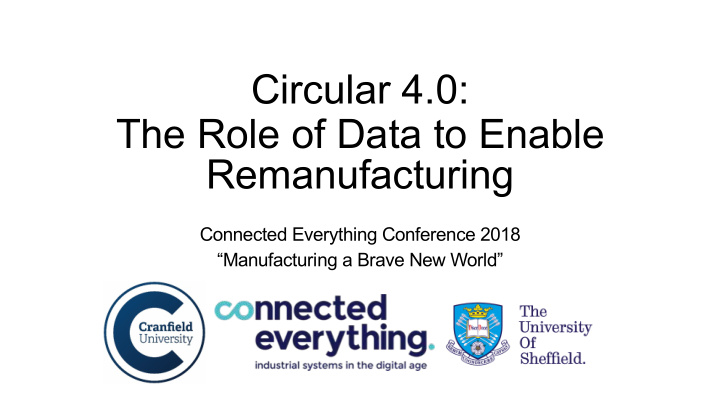



Circular 4.0: The Role of Data to Enable Remanufacturing Connected Everything Conference 2018 “Manufacturing a Brave New World”
Research Team Industry Partners Dr Fiona Charnley Dr Mariale Moreno Mr Okechukwu Okorie Professor Ashutosh Tiwari Dr Divya Tiwari Mr Windo Hutabarat
Circular Economy “an alternative to a traditional linear economy (make, use, dispose) in which we keep resources in use for as long as possible, extract the maximum value from them whilst in use, then recover and regenerate products and materials at the end of each service life.” – WRAP (2017) How can we use data to enable Circular Economy? Circular 4.0!
The opportunity Intelligent Assets Knowledge Information Sensing & Data acquisition https://www.ellenmacarthurfoundation.org/publications/intelligent-assets
Exemplar: Riversimple Rasa • “Sale of service”: a single monthly fee that covers everything – the car, the maintenance, the insurance, the fuel • When a customer returns a car at the end of their contract, it is offered to the next customer • A distributed manufacturing model: small-scale operations near the markets they serve
Data flows and ‘Circular Interventions’
Data flows and ‘Circular Strategies’ Remanufacturing is a process of disassembly and recovery of an asset at a product and component level (Intelligent Assets 2017 EMF) Major challenge: stochastic nature of product returns. In particular, there is significant variability in the condition of the returns (Aras 2004)
The challenges in remanufacturing Lowers Increases cost cost Cost of disassembly and sorting Availability of Inventory holding costs for recovered parts returned parts at little cost Smaller batch sizes Savings in disposal Alternative manufacturing processes expenses Remanufactured product discount Uncertainty in input In-use data to reduce Help in making quantity/quality uncertainties remanufacturing decisions
Remanufacturing: use of data Structured data: spreadsheets, relational databases, enterprise data warehouse, files stored in manufacturing PCs Semi-structured data: data from sensors, relays, RFID, XML, time series data structures Unstructured data: operator shift reports, machine logs, error logs, texts, images, audio/video, manufacturing collaboration on social platforms Okorie et al (2018) ‘ A Decision-Making Framework for the Implementation of Remanufacturing in Rechargeable Energy Storage System in Hybrid and Electric Vehicles’ SPS 2018
Remanufacturing decision-making: OEM Business-level Reman Hub Generic remanufacturing process Remanufacturing decision-making with data Ijomah et al 2017 Okorie et al 2018
Remanufacturing decision-making: Shop-floor level CPQ = Certainty of Product Quality
Conclusion • True Circular Economy will likely be data-driven “Truly circular economies arguably cannot exist without the Internet of Things. To be sustainable, a system must be responsive; actions and behaviours must be connected via data and knowledge. “ Tim Brown CEO, IDEO (Intelligent Assets 2017 EMF) • A ‘menu’ of CE intervention and CE strategies can help in devising CE data flows that are fit for purpose • Remanufacturing is a key feature of Circular Economy but uncertainties in quantity/quality poses major challenges • Simulations of CE remanufacturing scenarios are useful to validate the value of data for each CE stakeholder
Next step
Thank you. Connected Everything Conference 2018 “Manufacturing a Brave New World”
Recommend
More recommend